In the last four years I’ve had a simple focus – how can I get students critically thinking, creating, collaborating, and communicating (The 4 C’s) with their learning? This is what drives my teaching with or without technology. However, when technology is used, I hope it’s intentional and ties to the 4 C’s listed above. This is why I love EduProtocols so much – it’s practical, intentional, ties to the 4 C’s, and provides consistency for the students and myself.
With the students I try to see each student as unique with their own set of strengths. One question that helps me with students – How can I give every student a chance to be successful? Everyone in this life deserves a chance to have fun and be successful with something and if my class is that one chance then I’m happy with that.
This week, we finished the Constitutional Convention, did a mini-lesson on Federalists and AntiFederalists, and we began one of my favorite units – The Constitution. The main goal of the Constitutional Convention was having the students analyze, and evaluate, compromises from the Convention. We used a 3xCER and Nacho Paragraph to complete this unit.
Following the Constitutional Convention, I do a mini lesson on Federalists and Anti-federalists. I created a choice board for this. The choice board has clear learning goals, an application activity, and an evaluative activity.
On Thursday, students wrapped up the Federalists/AntiFederalists unit. Then we began the Constitution Unit with a 10 question quiz from the United States Citizenship and Immigration services quiz. The goal is to reach six questions correct, which is rarely accomplished.
Monday – 3xCER and Nacho Paragraph, Fast and Curious
Tuesday and Wednesday – Federalist/AntiFederalist Choice Board
Thursday – Citizenship Test, Vocabulary Evaluation
Friday – Resource Rumble – Parts of the Constitution
Monday
On Friday, students completed a 3xCER evaluating why the founding fathers kept slavery in the Constitution. I wanted them to keep that practice going writing claims, evidence, and reasoning. With EduProtocols, reps are important!! On this 3xCER, the question was, “Should the Constitutional Convention be considered a success?”
On the CER doc, the first column had the students evaluate the convention as a success. The middle column had them evaluate it as unsuccessful. The third column had students create their own claim about the convention.
As we did this activity, I noticed that students are getting better at writing claims. The evidence piece needed some work. The students had trouble remembering the compromises and classifying them as a success or not. As a result, by 5th period, I created a concept sort to help students evaluate the compromises at the convention. I created a list of items and had students sort them into categories…
- The Great Compromise
- Small states and large states compromised to create 3 branches of government and set up our modern day Congress.
- The Founding Fathers created a government that still exists today.
- The 3/5th Compromise.
- They had a chance to end slavery, but built slavery into the words of the Constitution.
This is just a small sample of the evidence I listed out for students to sort. This definitely helped the students create, and write, evidence which ultimately helped their reasoning skills as well.
After students wrote their claims with evidence and reasoning, I set up a Socrative short answer question and share the student login link. Students signed into Socrative and I had them use their last column of the CER to construct a paragraph. As students submitted their paragraphs, I was giving feedback on the evidence and reasoning.
After a short time, I hit the “start vote” button in Socrative and the students were able to read each other’s paragraphs. We voted for the best paragraph, then I created a new Socrative Short answer question.
I copied and pasted the best paragraph into the question box of the new Socrative short answer question. Students signed back into Socrative, and we did a Nacho Paragraph. I instructed the students to copy and paste the paragraph into their response box, and I was going to have them edit the paragraph. Here are the edits I had them do…(It’s important to teach them NOT to submit their response until you tell them to do so)…
- Rewrite the claim so it still makes sense with the paragraph.
- Add a transition word to the evidence. With this one, I heard, “How do I do that?” My response was, “Look it up.”
- Add a concluding sentence to the paragraph.
At first, the nacho paragraph seemed like a lot to them, but they started getting the hang of it. The student whose paragraph we chose said they felt weird that everyone was editing their paragraph. This is definitely something I will have the students do again because this is phenomenal for working on writing skills.
At the end of class, I ran a Gimkit Fast and Curious that I told them was for a grade. It’s amazing how much the class averages shot up when I mentioned this! Every class average fell between 85% and 96%. Amazing stuff.
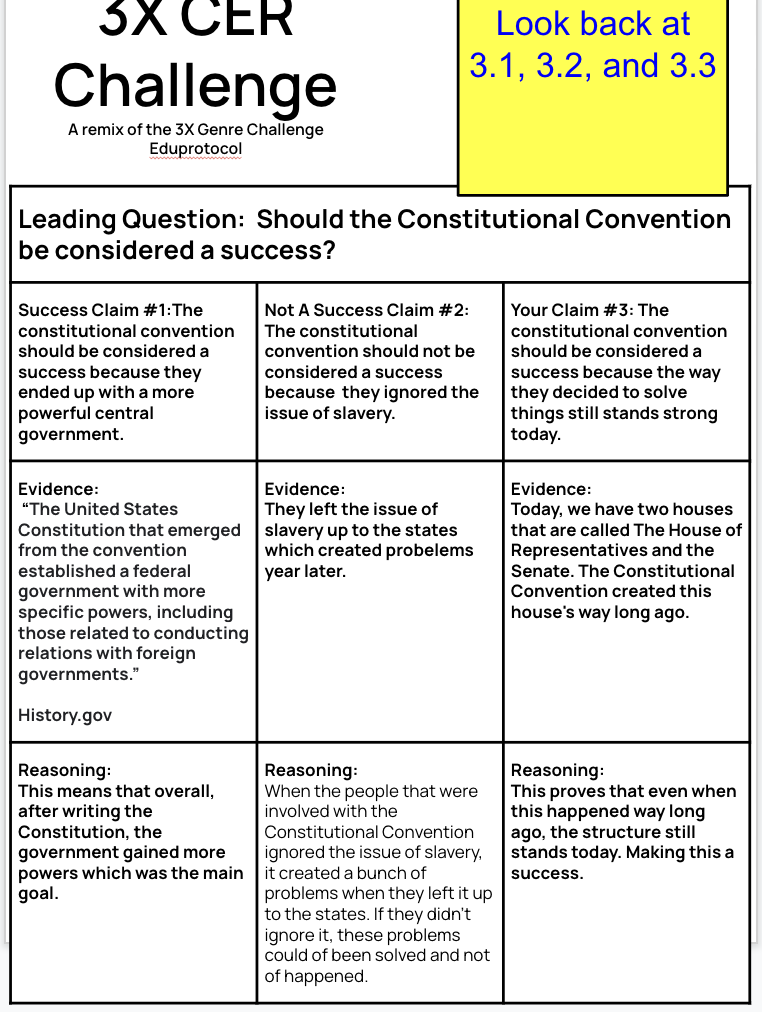
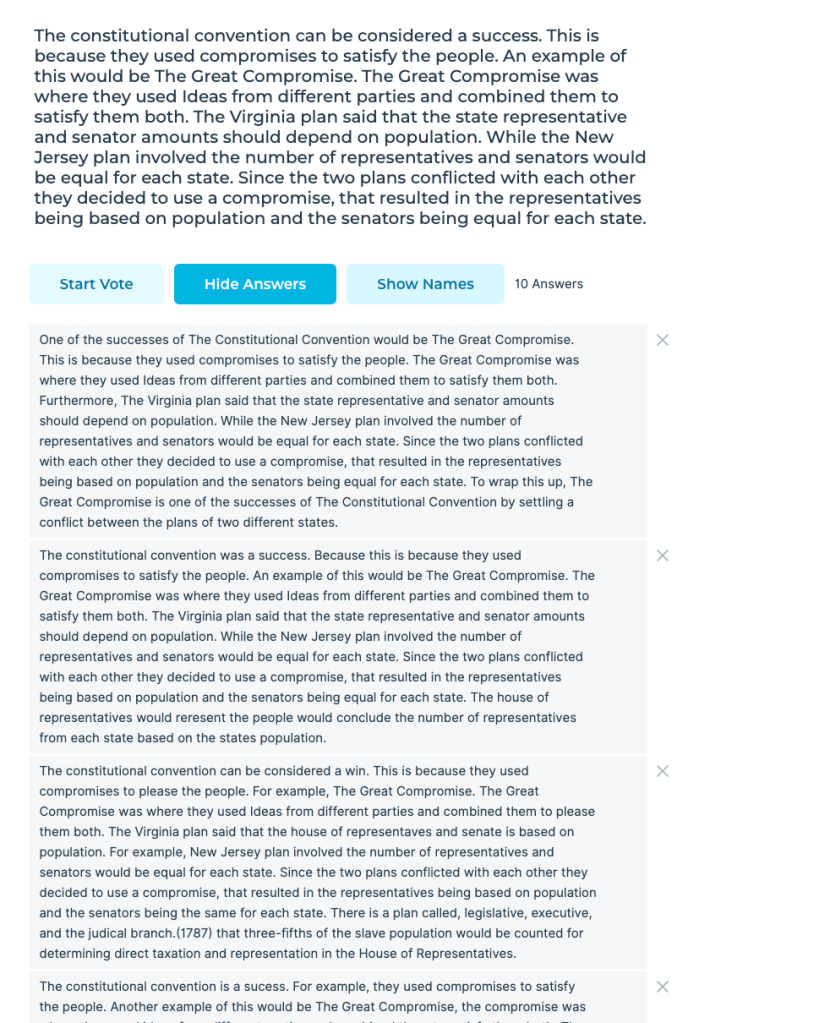
Tuesday and Wednesday
After the conclusion of the Constitutional Convention unit, I moved into a mini-lesson on Federalists and AntiFederalists. It’s funny because I often refer back to this blog to see what I did last year. When I saw I created a choice board, I was like, “Sweet!”
Before I had students get into Federalists and AntiFederalists, I had them look up the definition for the word “Federal.” Google provides three definitions so I asked them, which definition would work best to help them understand the word Federalist. They agreed that this definition would help, “relating to or denoting the central government of the US.”
My next question was, “Based on that definition, what do you think a Federalist was?” A proud teacher moment happened when a student who struggles with reading, inferencing, and making connections spoke up and said, “Oh, they supported a strong central government.” Then I asked, “What do you think an ANTI-Federalist was?” Another connection made, “They would not support a strong central government.” Then I asked, “Why not?” The response was, “Because they wanted strong state governments and would probably support the Articles of Confederation.” I cried 😭 a little.
Earlier in the week, I had a student request that I lecture and they could take notes. I asked, “Why would you want that?” The response was, “Because you’re good a telling stories and do a nice job of relating the stories to us.” The lecture style is more for students who need structure and certainty to help them process what they are learning. The choice board I set up had a variety of activities for all types of processing styles. The activities on the choice board included the following:
- Quizizz for the check for understanding – students could take this twice.
- EdPuzzle to take the place of a lecture style.
- WordWall for practice – a concept sort.
- CyberSandwich for those who want some partner work and discussion.
- A student paced PearDeck – sketch and tell included.
- Frayer Models
- Primary Source analysis from SHEG.
The choice board also included clear learning goals:
- I can identify and explain 2 differences between Federalists and AntiFederalists.
- I can identify the compromise made between Federalists and AntiFederalists over the Constitution.
Finally, I also included four application activities on the choice board to choose from. The application activities included:
- Imagine you are a Federalist or AntiFederalist – write a letter persuading people to accept or not accept the constitution. Include 4 or more important facts/reasons in your letter.
- Select a Federalist or AntiFederalist – design an action figure (An example) (this is on paper – get the paper from me)
- Story Cubes – relate 8 story cubes to the beliefs and characteristics of Federalists and AntiFederalists. (This is on EMC2Learning)
- Choose a Federalist or Anti-federalist – if they got a tattoo, what design would they get and why? Draw your design on paper, take a picture and add it to the slide. Then fill in the missing details around it. (This is on EMC2Learning)
Over 2 days, students did geat completing the activities. The most chosen activities were the EdPuzzle, WordWall, and Quizizz. This was chosen the most because it was the quickest and easiest to do. However, I challenged the students to complete the Word Wall with 100% accuracy in under one minute.
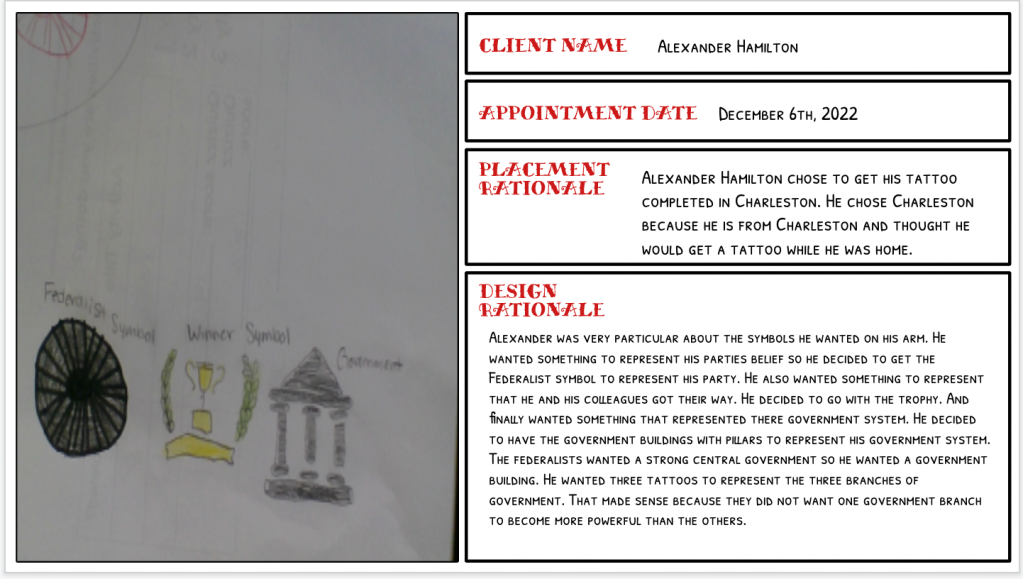
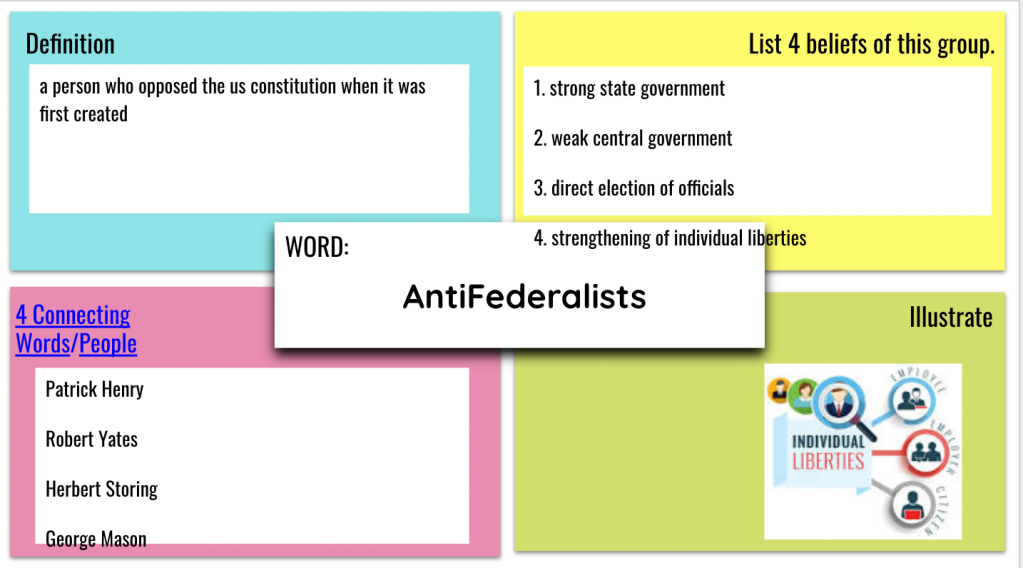
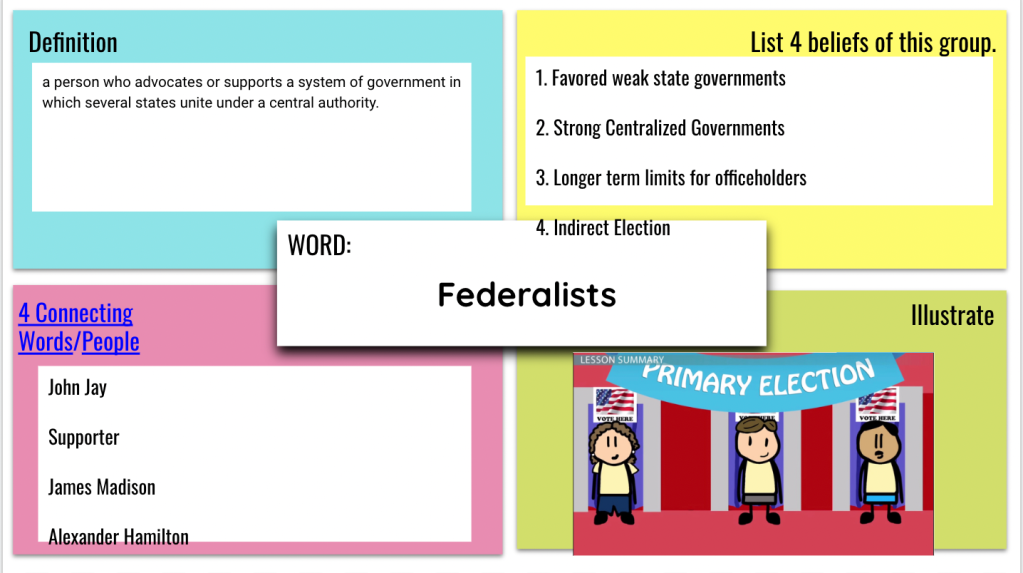
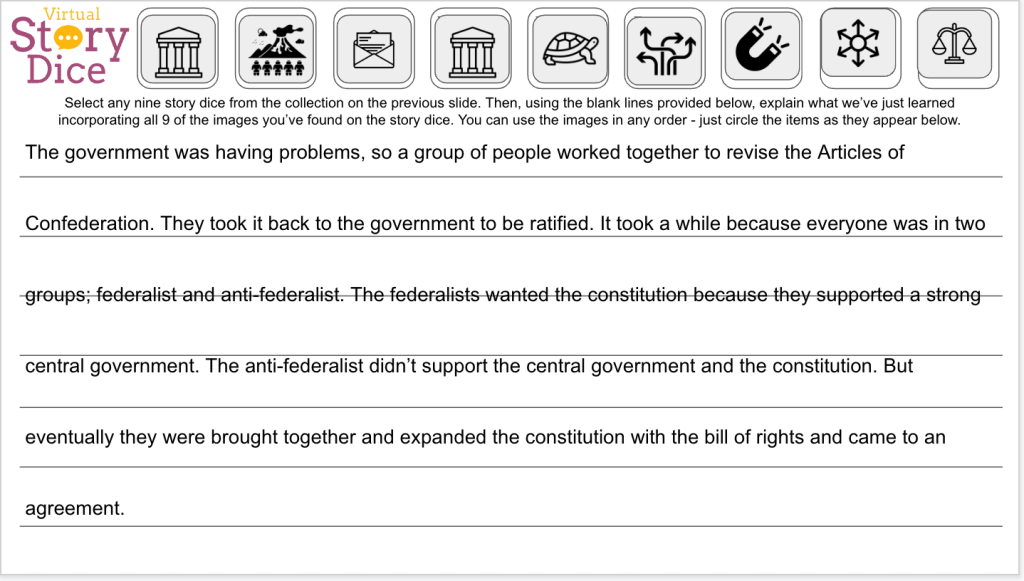
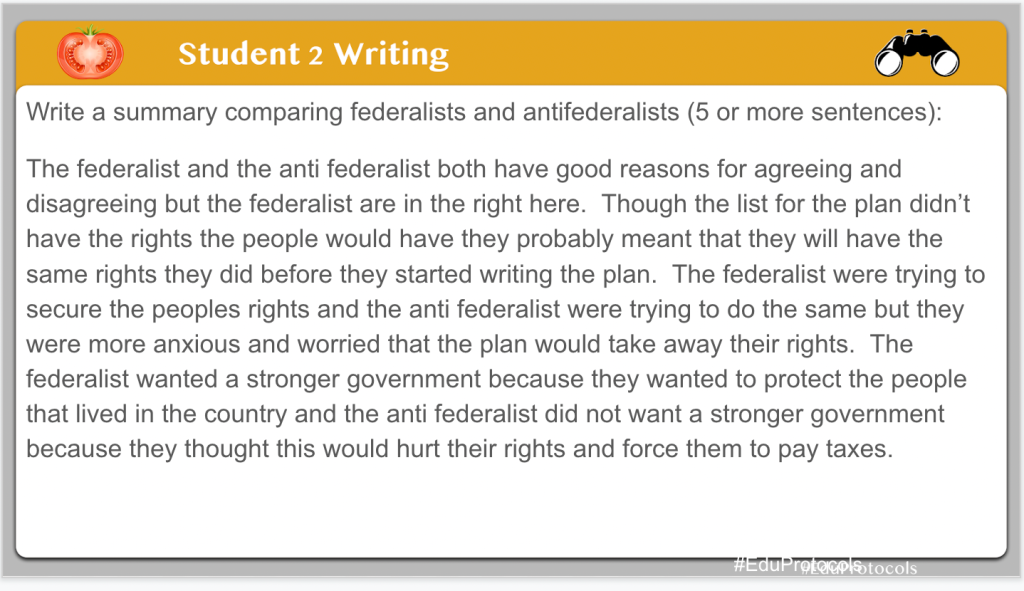
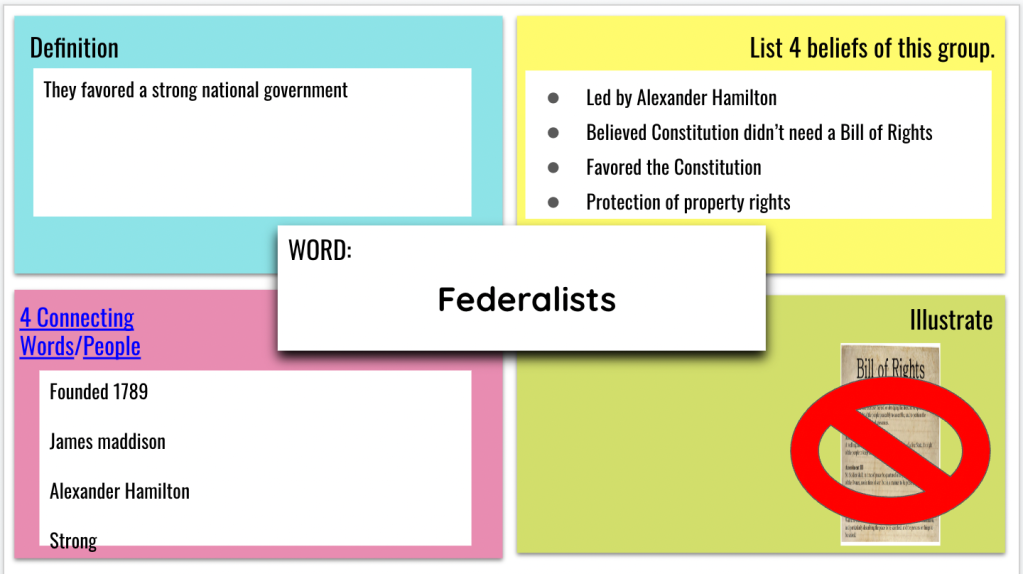

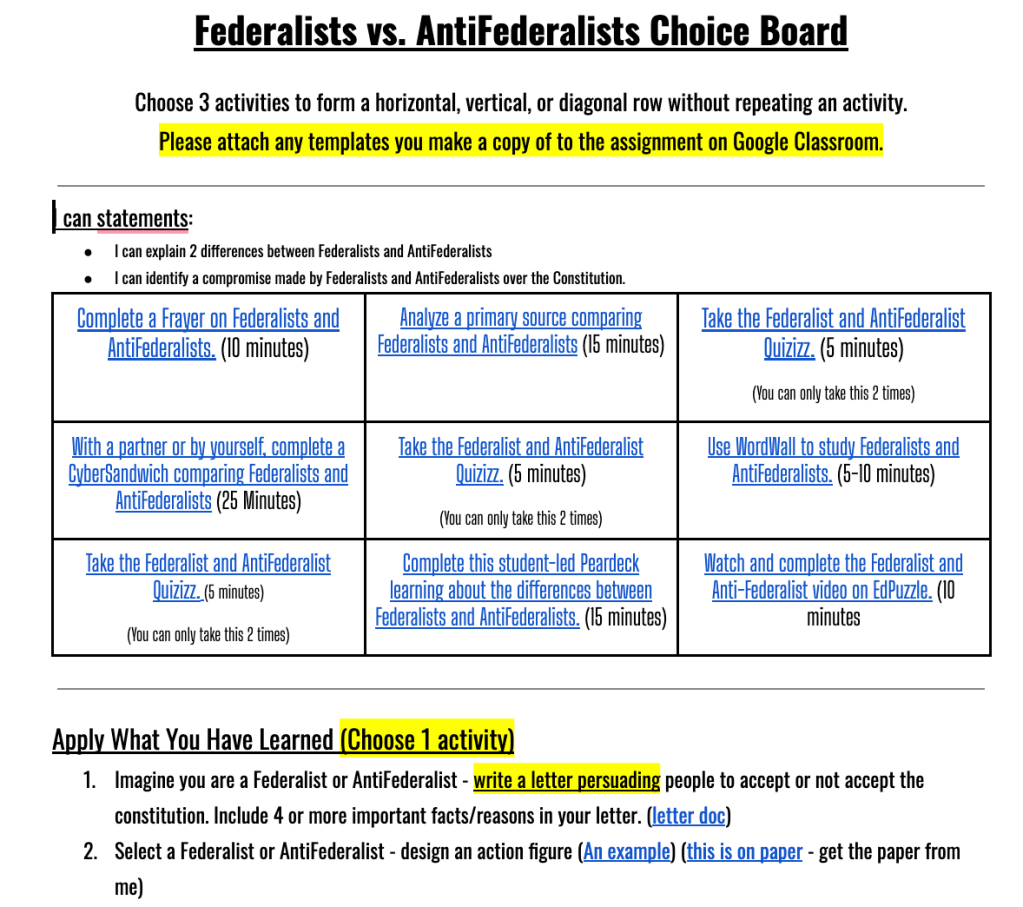
Thursday
On Thursday, we began my favorite unit – The Constitution. I love government. I love teaching government. I love the challenge of taking something that is not exciting, not easy to connect with and making it exciting. Here are my two compelling questions for the unit:
- How does the constitution limit government’s power?
- What are 6 principles of government found in the Constitution and how do they relate to your life?
I always begin this unit with a citizenship test from the USCIS website. I ask ten questions that relate to the unit, and students need to get six correct. I ask the questions out loud and they need to write their responses on paper. I use this as baseline data for the unit. Here is my data:
- First Period – 2/20 got six correct. 27% class average.
- Third Period – 0/29 got six correct. 24% class average.
- Fifth Period – 2/24 got six correct. 26% class average.
- Seventh Period – 2/20 got six correct. 24% class average.
- Eighth Period – 3/14 got six correct. 34% class average.
After the citizenship test, I have the students evaluate their own knowledge of vocabulary words from the unit. I had them go through 12 words and decide the following:
- Know it – they could write a definition in seconds without looking it up.
- Not sure – they have seen the word but don’t know how to define it.
- Don’t know it – they have never seen the word before.
I noticed that some thought they knew Federalism. However, they confused this with the Federalists. Some thought they knew Bill of Rights and Republic but didn’t have keywords in their definitions. For example, for a republic, most students left out the words representative or elected. So, it’s important to circulate and give quick feedback during this activity.
With the time we had left, I ran a “secret” Gimkit on the states. Students like the secret Gimkit. Sometimes it’s a Gimkit about states, 4th grade trivia, or basic things they should know. I hear a lot of teachers complain that students don’t know “stuff” anymore. I would agree this is true, but why not use reps with Gimkit to address the issue? This is the 4th time my classes have used the Gimkit about states – we began the year with a 60% average, and we are now above 80% on state recognition.
Friday
Before I get into the principles of the Constitution, it’s important for students to understand the structure of the document. I gave students a choice: I could lecture on the Articles and amendments of the Constitution, or they could do a Resource Rumble.
The students chose the Resource Rumble. Students used the Constitution in the textbook to answer a variety of questions. As I approved the questions, they collected legos. At the end of the resource rumble, they had to build something with their legoe related to Article I, Article II, or Article III.

2 thoughts on “The Week That Was In 505”